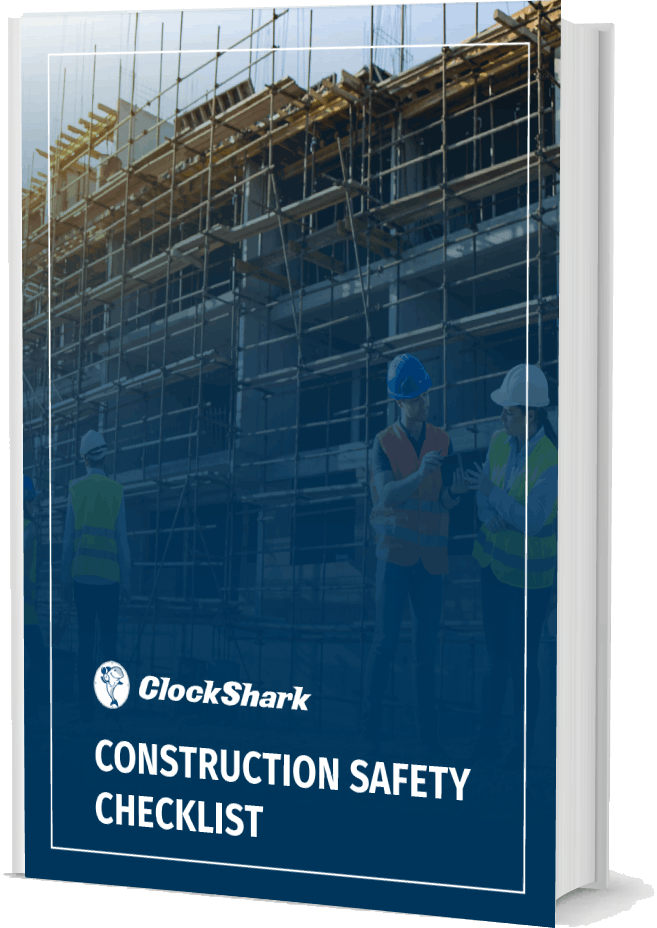When we see “construction safety compliance,” images of large, corporate or industrial jobsites come to mind, but safety compliance on the jobsite is critical for all construction and field service companies, regardless of size.
But how can you manage safety compliance with your employees, especially if you are not with them all the time? This post is to help you manage occupational safety compliance in a way that ensures everyone is on board and working in a safe work environment.
Why Is Safety Compliance Important in Construction?
Obviously, having a safe working environment is good for your employees’ health and occupational safety, but there’s more to it than just that. OSHA’s latest data shows the top 10 construction safety violations to be:
- Fall Protection
- Respiratory Protection
- Ladders
- Hazard Communication
- Scaffolding
- Fall Protection Training
- Control of Hazardous Energy (lockout/tagout)
- Eye and Face Protection
- Powered Industrial Trucks
- Machinery and Machine Guarding
The penalties for these violations can be more than $14,000 a day per violation, so they add up quickly.
With proper construction health and safety compliance, you’ll have lower costs associated with things like worker’s compensation insurance, less faulty equipment, and lower medical expenses. You’ll also reap the rewards of having higher morale among your workers which, of course, will improve productivity and engagement.
How to Manage Safety Compliance on the Jobsite
The most important part of construction safety and compliance is having your employees on board with it. Occupational safety compliance in construction should not be an option; rather, it should be a core tenet of your organization that is taken seriously by all stakeholders.
Sometimes, though, it can be challenging to get employees to get - and stay - on board and to effectively monitor occupational safety, especially if you have multiple jobsites and a lot of employees.
Here is how you can ensure you have a safe, hazard-free workplace for your workers.
1. Get Employees on Board
Your human capital is the most valuable resource for your company. Before you hire anyone, they should know the importance of your company’s occupational safety policies, so they come through the door understanding the requirements. A culture of safety - fortified with construction safety training compliance - will permeate the entire organization so that everyone - from owners to subcontractors to laborers - understands it as a requirement.
Let your managers and supervisors see the cost of safety violations - both financially and morally - and get a buy-in from them, to enforce solid safety programs and procedures. Provide them with concrete jobsite safety checklists and frequently discuss safety programs and safety training, so they do so with their crews.
Let your employees know it is safe to report construction safety violations and concerns. Be sure they know they will not face retaliation for sharing them and foster a culture of open communication. Remind them that safety is everyone’s concern.
2. Provide Effective Construction Safety Compliance Training
Safety training can certainly be dull, but if you want safety compliance, you have to have the safety training. OSHA requires that employers provide training for any hazardous activities, so it is your responsibility to see that your workers are adequately trained and understand your company’s safety programs.
Fortunately, not all occupational safety training has to be boring. You can provide flexible scheduling, so workers can complete their training when it’s convenient for them.
You can also change up the way the safety training is done. Options like microlearning, or full- or partial-gamification. While construction health and safety compliance training is a very serious issue, it can feel overbearing and complicated if the wrong tone is used. Communicate with excitement the benefits of occupational safety training, and get your workers excited about learning, too.
OSHA provides construction safety compliance training, but you can also leverage your more experienced workers’ knowledge to help train newcomers as well with on-the-job training and demonstrations. Note that you may need to get specialized training for new or different jobs with unique hazards.
3. Create and Enforce Clear Safety Programs
From evacuation and fire protection to emergency care and scaffolding, you’ll need clear and concise health and occupational safety policies. When creating an effective health and safety program, there are questions you should first ask yourself.
- What methods do similar companies to yours use for safety compliance?
- What are your goals with a safety compliance policy? (No injuries, worker’s compensation costs, fewer lost work days, etc.)
- What obstacles do you face at this time?
- How can these obstacles be eliminated?
- Do you have any workers who have no regard for health and safety and, if so, can they be trained to take it seriously?
OSHA recommends a Four-Point Workplace Program that includes:
Management Commitment and Employee Involvement
Make sure to share your commitment to occupational safety with your workers. Involve them in your health and safety compliance and invite them to participate in identifying when something needs to be inspected. Ensure everyone is familiar with your safety policy. You can even have it included as a part of their employment contract.
Have as many people as possible, involved in the occupational safety compliance of their jobsites and make sure everyone is clear about what their responsibilities and roles are.
Worksite Analysis
Not being on a jobsite does not mean you’re not responsible for the safety of it. OSHA offers confidential, on-site consultations for free. These consultations can be effective ways for your employees to learn more about jobsite safety compliance.
Put systems in place for daily safety compliance checkups for employees so they can rectify any hazardous situations or identify possible new ones.
Hazard Prevention and Control
Once you analyze your worksite, you’ll have a better idea of potential hazards and be better able to create policies and procedures around them. Remove any hazards that cannot be remedied.
Check with your workers to ensure all of your equipment is safe to use and, if not, make plans to replace it. Ensure you have adequate PPE and safety equipment for everyone that is compliant and functioning properly.
Employee, Manager, and Supervisor Training
As mentioned above, leverage any resource you can to ensure everyone in your company gets the right construction safety compliance training.
Some elements that can be included in an effective safety management policy include:
- General health and safety policy
- Company rules
- Safe practices and procedures
- Preventive maintenance
- Training and communication
- Emergency preparedness
- Inspections and reporting
- Possible special considerations for unique industries
- Penalties for noncompliance
Each company is different so you may not need all of these items or you may need more. Ultimately, it is your responsibility to ensure your safety policies are clear, concise, and understood by everyone.
4. Engage Employees
Engaged employees participate more, stay more loyal, and enjoy their work best. Getting your employees engaged in your safety goals is a necessary part of reaching them. To get your employees engaged and participating, there are a few things you can do.
5. Have Regular Safety Meetings
Start each morning with a safety meeting. This will allow them to touch base with their supervisors and share any concerns they may have. You can also use these meetings to go over any changes to the policy or even provide a mini hands-on training. Daily safety meetings don’t have to be long and dull. You can make them fun and encouraging, too.
6. Ask For Their Input (This Provides Buy-In)
If you ask for their input, they will feel more comfortable talking to you about it. When they are a part of identifying issues and making suggestions, you’ll have more buy-in from them and they’ll feel valued.
7. Hold Employees Accountable
Possibly one of the most unpleasant aspects of being a boss but it’s crucial that employees are held accountable when they go against your company’s safety policy. You’ll need to have a system in place that provides consistent penalties for everyone and you will need to be fair with all of your employees.
8. Reward Good Behavior/Practices
Conversely, rewarding employees who are safety-conscious will go a long way, as well. It does not have to be extravagant; a note in their paycheck acknowledging their contribution or a pat on the back works just as well as anything to make them feel valued for how they are doing.
Save Time and Money with ClockShark
Conclusion
Construction safety compliance is a serious issue for construction and field service industries, that costs billions of dollars annually. It’s worth investing in the tools you need to stay compliant and keep your workers safe and healthy and build your company’s reputation as a safe one to work for.






